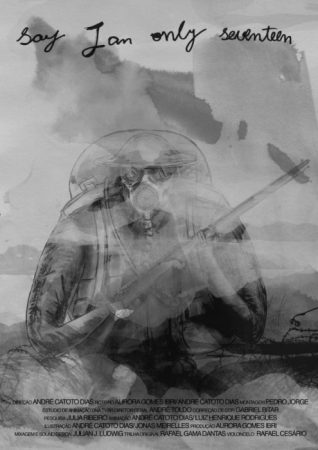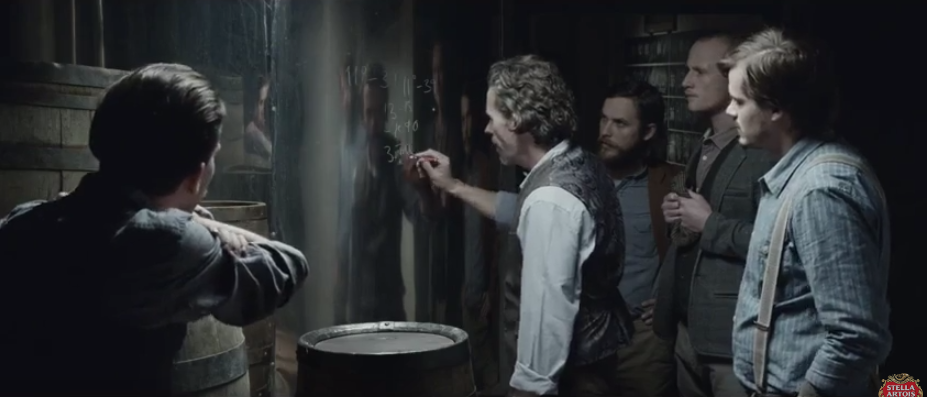AUDIO RESTORATION
Noise reduction and audio restoration are vital processes in cleaning and enhancing sound quality, especially important in location sound and direct sound recordings. These techniques involve identifying and removing unwanted sounds – such as hums, clicks, or background noise – restoring the original clarity of the audio. Sound cleaning is a crucial step, especially in productions that rely on live recordings, where control of the sound environment is limited. We use advanced technologies and precise techniques to isolate and remove interference, preserving the integrity and naturalness of the original recordings. Check out our work in the film The Pathways Fairy, a production filmed in Tanzania.
DIALOGUE EDITING
We specialize in dialogue editing for films and TV series. We use specialized tools like Izotope RX6 to perform careful work, preparing the direct sound for the final mix. Check out the results in the film Metanoia, voted best film of 2015 by iTunes (Europa Filmes, O2 PLAY).
SOUND DESIGN / SOUND EDITING
Sound Design is an essential art in audio post-production, where every sound detail is carefully crafted and shaped to enrich the audiovisual experience. Our approach to sound design covers everything from capturing original audio to refined sound editing, ensuring that each sound element is in perfect harmony with the project’s vision. Below is an example of Sound Design done for Google, as well as an Audiovisual project.
DUBBING AND ADR
In productions of any size, there may be a need for dubbing (ADR) when direct sound encounters technical issues. In addition to “corrective” dubbing, we also offer voices for animations and foreign language versions. Check out the voiceover and dubbing service at Loc On Demand.
FOLEY
Foley is the art of recreating everyday sounds for audiovisual productions, bringing realism and depth to the sound experience. This technique involves recording custom sound effects, such as footsteps, creaky doors, or the sound of moving fabrics, meticulously synchronized with actions on screen. Foley artists use a variety of materials and surfaces to simulate specific sounds, capturing every subtle detail to enrich the visual narrative. Check out the results in the film Say I am Only Seventeen.
LOUDNESS DELIVERY
Globo and its affiliates have adopted a new standard for audio control during commercial breaks. Audio finalization focusing on loudness (perceived volume) is a crucial process to ensure that the sound content has a consistent and adequate volume level for different platforms and devices. This practice involves adjusting audio levels to meet established loudness standards, such as those defined by EBU R128. Loudness finalization is essential for television, cinema, music, and podcasts production, contributing to a pleasant and professional sound experience. Check out our work for Stella Artois and Budwiser.
Frequently Asked Questions
What is part of the audio mixing process for a film?
In the world of audiovisual post-production, audio mixing for films is an art that requires precision and skill. This process begins with the careful balance of dialogue, ensuring that each word is clear and audible without overshadowing other sound elements. Music is then skillfully integrated, enriching the visual narrative without dominating it.
A crucial aspect is the inclusion and mixing of sound effects and foley. These effects are essential to bring authenticity to the scenes, recreating realistic sounds that capture the essence of each moment. Additionally, environmental sound design is meticulously crafted to establish the setting and mood, immersing the viewer in the film’s environment.
Sound editing also plays a key role in ensuring the fluidity and consistency of audio throughout the film. This includes precise cuts and adjustments to ensure that each transition is smooth and coherent. Furthermore, loudness normalization is performed to meet industry standards, providing a comfortable and uniform listening experience.
For films that demand a more immersive sound experience, mixing in 5.1 Surround Sound is an additional component that offers incredible depth and dimension, placing the viewer at the center of the action.
Each step of this process is conducted with careful attention to detail, ensuring that the audio mixing of your film significantly contributes to the emotional impact and success of the project. With our expertise in audiovisual post-production, we transform sound into an unforgettable experience for the viewer.
This text, optimized for SEO, incorporates key terms such as “audio mixing,” “film,” “audiovisual post-production,” “foley,” and “5.1 Surround,” designed to attract interested visitors and increase the visibility of your website or service.
What is Foley?
Foley is a fascinating and crucial technique in audio post-production, especially in the world of cinema and television. Named after Jack Foley, a pioneer in the field, this technique involves creating and recording unique sound effects that are added in post-production to enhance the sound quality of a film or TV show.
The Foley process is almost like an art form, where Foley artists skillfully recreate sounds that occur naturally in a scene. These can range from footsteps and clothing rustles to more complex sounds like clinking silverware or rustling leaves. The goal is to produce sounds that are as realistic and natural as possible, seamlessly integrating with the original audio captured during filming.
An interesting aspect of Foley is that often the sounds are created in unconventional ways. For example, crushing fruits may be used to simulate injury sounds, or dried leaves may be crumpled to mimic the sound of a fire crackling. These effects are carefully synchronized with the actions on screen, adding a layer of realism and depth that wouldn’t be possible with just the audio captured on set.
Foley is not just about reproducing realistic sounds, but also about enhancing the visual narrative, adding a sonic dimension that enhances the viewer’s immersion in the story. It’s a powerful tool that brings the visual world to life, creating a richer and more engaging experience for the audience.
This text, optimized for SEO using keywords like “Foley,” “audio post-production,” and “sound effects,” aims to educate readers about the importance and artistry of Foley while enhancing online visibility for those interested in this unique aspect of audiovisual production.
What is 5.1 mixing?
5.1 finalization is an essential process in audio post-production, especially relevant in the context of films, television, and multimedia content. This term refers to the creation and mixing of a soundtrack in the 5.1 Surround Sound format, an industry standard for immersive and high-quality audio experience.
The “5.1” in 5.1 finalization represents the configuration of the speakers used: five full-range speakers and one subwoofer (the “.1”) for low frequencies. The five speakers are positioned around the listener – usually two in the front, two in the back, and one in the center – to create a surround sound field.
During the 5.1 finalization process, different sound elements such as dialogue, music, sound effects, and foley are carefully balanced and distributed among the audio channels. This not only ensures that each element is heard clearly but also creates a sense of space and movement.
This technique is crucial for providing a more realistic and immersive experience for the viewer. In an action movie, for example, 5.1 finalization can make the audience feel like they are in the middle of a car chase or in the heart of a storm. In dramas, it can accentuate the emotional atmosphere, engaging the viewer in the story.
In summary, 5.1 finalization is more than just a mixing technique; it is a powerful tool for storytelling, allowing content creators to bring their visions to life with extraordinary sound richness. By using sound to influence the viewer’s experience, 5.1 finalization plays a fundamental role in transforming an audiovisual project from good to exceptional.
What is Dolby Atmos?
Dolby Atmos is a revolutionary audio technology that has elevated the sound experience in movies, music, games, and broadcasts to a new level. Unlike traditional surround sound systems like 5.1 or 7.1, Dolby Atmos stands out by adding a vertical dimension to sound, allowing for the creation of a truly immersive three-dimensional audio experience.
The secret behind Dolby Atmos is how it manipulates audio as individual sound objects. In a traditional system, sounds are assigned to specific channels (such as left, right, or center). However, with Dolby Atmos, sounds can be positioned and moved in a three-dimensional space. This means that audio can be placed and moved anywhere around the listener, including above them, creating the sensation of being fully immersed in the sound environment.
For example, in a movie scene with rain, Dolby Atmos allows the sound of the rain to seem like it’s coming from above, replicating the experience of being caught in a storm. Similarly, in an action scene, the sound of a helicopter can realistically move over the audience’s heads, increasing immersion and the reality of the scene.
This technology not only enhances the viewer’s experience in cinemas but is also available for home use through soundbars, home theater systems, and even some smartphones and laptops. Dolby Atmos is also becoming increasingly popular in music, enabling a new form of mixing that offers listeners a richer and more immersive experience.
In summary, Dolby Atmos is more than just an evolution in surround sound; it’s a complete transformation in the way we experience sound, offering unprecedented depth, clarity, and realism that changes how we perceive audio in our favorite movies, music, and games.
What is Audio Post-Production for film?
Audiovisual post-production is a critical phase in the process of creating films, TV shows, commercials, games, and other multimedia content. It is at this stage that the audio recorded during production is refined, edited, mixed, and enhanced to ensure that the sound quality of the final product is of the highest standard.
This process begins with dialogue editing, where voice recordings are cleaned, unwanted noises removed, and adjusted for clarity and continuity. Next comes the sound design phase, which involves creating sound environments and adding sound effects to accentuate the visual narrative. Here, sounds such as door slams, footsteps, and ambient noises are added or enhanced to add realism and immersion to the scenes.
A crucial component of audio post-production is Foley, the art of recreating everyday sounds in the studio, synchronizing them with visible actions on the screen. This can include everything from the sound of footsteps to the clinking of cutlery.
Additionally, music is carefully selected or composed and then mixed with the other audio elements. The final mix is where all these elements – dialogue, music, sound effects, Foley – are balanced and harmonized to create a cohesive soundtrack. In many cases, this stage also includes mixing for specific audio formats, such as surround 5.1 or Dolby Atmos, for a more immersive experience.
Finally, there is mastering, where the entire soundtrack is adjusted to meet quality and loudness standards, ensuring consistent playback on various platforms and devices.
Audiovisual post-production is not just about technique but also about the art of using sound to tell stories, evoke emotions, and immerse the audience in the world created on the screen. It is a fundamental stage that transforms a good production into a memorable work.








